欧盟玩具安全标准EN71-8
- 格式:pdf
- 大小:2.23 MB
- 文档页数:38
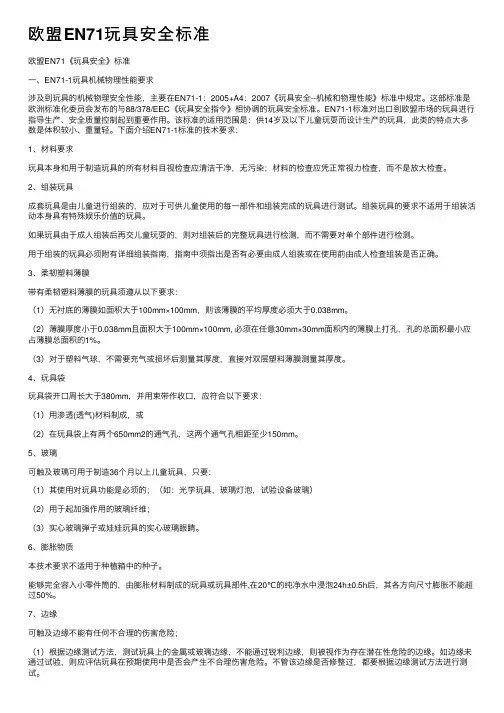
欧盟EN71玩具安全标准欧盟EN71《玩具安全》标准⼀、EN71-1玩具机械物理性能要求涉及到玩具的机械物理安全性能,主要在EN71-1:2005+A4:2007《玩具安全--机械和物理性能》标准中规定。
这部标准是欧洲标准化委员会发布的与88/378/EEC《玩具安全指令》相协调的玩具安全标准。
EN71-1标准对出⼝到欧盟市场的玩具进⾏指导⽣产、安全质量控制起到重要作⽤。
该标准的适⽤范围是:供14岁及以下⼉童玩耍⽽设计⽣产的玩具,此类的特点⼤多数是体积较⼩、重量轻。
下⾯介绍EN71-1标准的技术要求:1、材料要求玩具本⾝和⽤于制造玩具的所有材料⽬视检查应清洁⼲净,⽆污染;材料的检查应凭正常视⼒检查,⽽不是放⼤检查。
2、组装玩具成套玩具是由⼉童进⾏组装的,应对于可供⼉童使⽤的每⼀部件和组装完成的玩具进⾏测试。
组装玩具的要求不适⽤于组装活动本⾝具有特殊娱乐价值的玩具。
如果玩具由于成⼈组装后再交⼉童玩耍的,则对组装后的完整玩具进⾏检测,⽽不需要对单个部件进⾏检测。
⽤于组装的玩具必须附有详细组装指南,指南中须指出是否有必要由成⼈组装或在使⽤前由成⼈检查组装是否正确。
3、柔韧塑料薄膜带有柔韧塑料薄膜的玩具须遵从以下要求:(1)⽆衬底的薄膜如⾯积⼤于100mm×100mm,则该薄膜的平均厚度必须⼤于0.038mm。
(2)薄膜厚度⼩于0.038mm且⾯积⼤于100mm×100mm, 必须在任意30mm×30mm⾯积内的薄膜上打孔,孔的总⾯积最⼩应占薄膜总⾯积的1%。
(3)对于塑料⽓球,不需要充⽓或损坏后测量其厚度,直接对双层塑料薄膜测量其厚度。
4、玩具袋玩具袋开⼝周长⼤于380mm,并⽤束带作收⼝,应符合以下要求:(1)⽤渗透(透⽓)材料制成,或(2)在玩具袋上有两个650mm2的通⽓孔,这两个通⽓孔相距⾄少150mm。
5、玻璃可触及玻璃可⽤于制造36个⽉以上⼉童玩具,只要:(1)其使⽤对玩具功能是必须的;(如:光学玩具,玻璃灯泡,试验设备玻璃)(2)⽤于起加强作⽤的玻璃纤维;(3)实⼼玻璃弹⼦或娃娃玩具的实⼼玻璃眼睛。
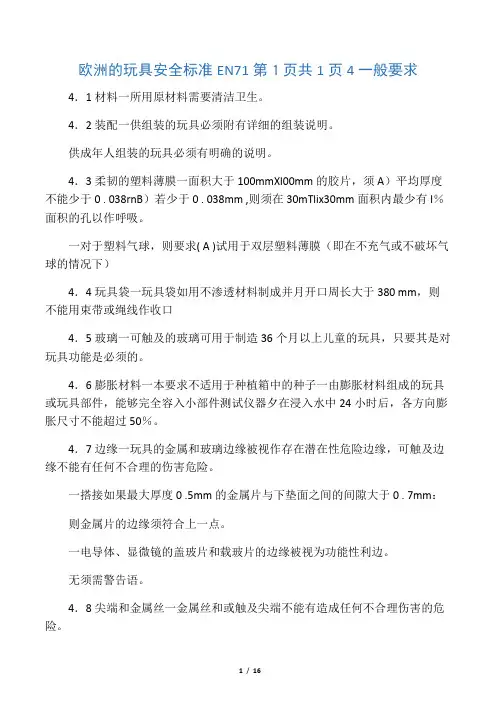
欧洲的玩具安全标准EN71第1页共1页4一般要求4.1材料一所用原材料需要清洁卫生。
4.2装配一供组装的玩具必须附有详细的组装说明。
供成年人组装的玩具必须有明确的说明。
4.3柔韧的塑料薄膜一面积大于100mmXl00mm的胶片,须A)平均厚度不能少于0 . 038rnB)若少于0 . 038mm ,则须在30mTlix30mm面积内最少有l%面积的孔以作呼吸。
一对于塑料气球,则要求( A )试用于双层塑料薄膜(即在不充气或不破坏气球的情况下)4.4玩具袋一玩具袋如用不渗透材料制成并月开口周长大于380 mm,则不能用束带或绳线作收口4.5玻璃一可触及的玻璃可用于制造36个月以上儿童的玩具,只要其是对玩具功能是必须的。
4.6膨胀材料一本要求不适用于种植箱中的种子一由膨胀材料组成的玩具或玩具部件,能够完全容入小部件测试仪器夕在浸入水中24小时后,各方向膨胀尺寸不能超过50%。
4.7边缘一玩具的金属和玻璃边缘被视作存在潜在性危险边缘,可触及边缘不能有任何不合理的伤害危险。
一搭接如果最大厚度0 .5mm的金属片与下垫面之间的间隙大于0 . 7mm:则金属片的边缘须符合上一点。
一电导体、显微镜的盖玻片和载玻片的边缘被视为功能性利边。
无须需警告语。
4.8尖端和金属丝一金属丝和或触及尖端不能有造成任何不合理伤害的危险。
一玩具功能必须的锐利尖端可用于供超过36个月以上的儿童使用的玩具,应提醒使用者注意锐利尖端的潜在危险。
一玩具内所含的易于弯曲和用于支持或加固框架的金属丝,按照弯曲测试时,不能断裂并产生锐利尖端或刺破玩具表面。
4.9凸起部件欧洲的玩具安全标准EN71第2页共2页一任何管状或类似的玩具的突出部份,因突出物的形状,直径和长度而存在潜在性的刺伤危险,应加上适当的保护。
一作为防护作用的部件在拉力测试中不得脱落。
一玩具伞伞骨的末端给予以保护,若保护失效,按利边尖点测试,伞骨末端不能有锐利的边缘和尖端,且伞骨最小的直径最小应为2mm,末端无毛刺,修整光滑,大致成半球形。
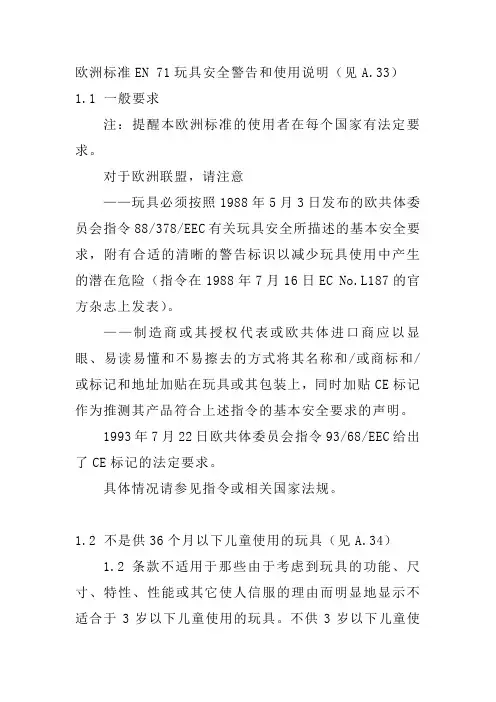
欧洲标准EN 71玩具安全警告和使用说明(见A.33)1.1 一般要求注:提醒本欧洲标准的使用者在每个国家有法定要求。
对于欧洲联盟,请注意——玩具必须按照1988年5月3日发布的欧共体委员会指令88/378/EEC有关玩具安全所描述的基本安全要求,附有合适的清晰的警告标识以减少玩具使用中产生的潜在危险(指令在1988年7月16日EC No.L187的官方杂志上发表)。
——制造商或其授权代表或欧共体进口商应以显眼、易读易懂和不易擦去的方式将其名称和/或商标和/或标记和地址加贴在玩具或其包装上,同时加贴CE标记作为推测其产品符合上述指令的基本安全要求的声明。
1993年7月22日欧共体委员会指令93/68/EEC给出了CE标记的法定要求。
具体情况请参见指令或相关国家法规。
1.2 不是供36个月以下儿童使用的玩具(见A.34)1.2条款不适用于那些由于考虑到玩具的功能、尺寸、特性、性能或其它使人信服的理由而明显地显示不适合于3岁以下儿童使用的玩具。
不供3岁以下儿童使用但可能对3岁以下儿童有危险的玩具,应附有警告标识,例如:“Not suitable for children under 36 months”or “Not suitable for children under three years”(“不适合36个月以下儿童”或“不适合3岁以下儿童”)同时附有简要说明,指出需要此项限制的特定危险。
注:“警告”这个词应放在句首。
在产品销售处的年龄警告应清楚易懂。
年龄警告标识应或者出现在玩具本身或者出现在零售包装上。
特定危险的说明可出现在单页宣传单或使用说明上。
年龄警告标识可用EN71-6中给出的符号代替。
1.3 乳胶气球(见4.12和A.16)乳胶气球的包装应加贴以下警告:“Warning! Children under eight years can choke or suffocate on uninflated or broken balloons. Adult supervision required. Keep uninflated balloons from children. Discard broken balloons at once.”(“警告!未充气或破裂的气球可能对八岁以下儿童产生噎住或窒息危险,需要成人监护,将未充气的气球远离儿童。
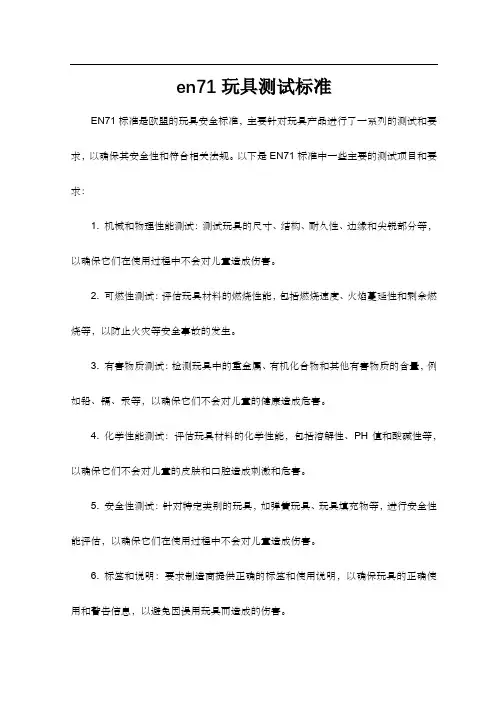
en71玩具测试标准
EN71标准是欧盟的玩具安全标准,主要针对玩具产品进行了一系列的测试和要求,以确保其安全性和符合相关法规。
以下是EN71标准中一些主要的测试项目和要求:
1. 机械和物理性能测试:测试玩具的尺寸、结构、耐久性、边缘和尖锐部分等,以确保它们在使用过程中不会对儿童造成伤害。
2. 可燃性测试:评估玩具材料的燃烧性能,包括燃烧速度、火焰蔓延性和剩余燃烧等,以防止火灾等安全事故的发生。
3. 有害物质测试:检测玩具中的重金属、有机化合物和其他有害物质的含量,例如铅、镉、汞等,以确保它们不会对儿童的健康造成危害。
4. 化学性能测试:评估玩具材料的化学性能,包括溶解性、PH值和酸碱性等,以确保它们不会对儿童的皮肤和口腔造成刺激和危害。
5. 安全性测试:针对特定类别的玩具,如弹簧玩具、玩具填充物等,进行安全性能评估,以确保它们在使用过程中不会对儿童造成伤害。
6. 标签和说明:要求制造商提供正确的标签和使用说明,以确保玩具的正确使用和警告信息,以避免因误用玩具而造成的伤害。
此外,EN71标准还针对不同年龄段的儿童制定了不同的安全要求和测试方法,以确保所有年龄段的儿童都能使用安全的玩具。
同时,EN71标准也不断更新和完善,以适应新的安全问题和法规要求。
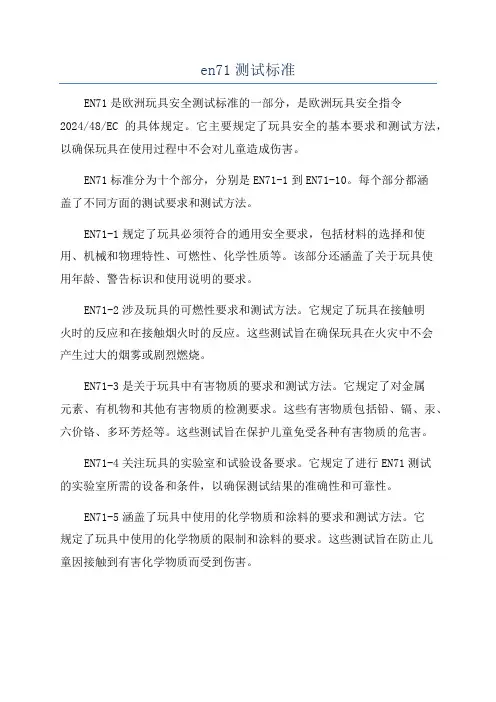
en71测试标准EN71是欧洲玩具安全测试标准的一部分,是欧洲玩具安全指令2024/48/EC的具体规定。
它主要规定了玩具安全的基本要求和测试方法,以确保玩具在使用过程中不会对儿童造成伤害。
EN71标准分为十个部分,分别是EN71-1到EN71-10。
每个部分都涵盖了不同方面的测试要求和测试方法。
EN71-1规定了玩具必须符合的通用安全要求,包括材料的选择和使用、机械和物理特性、可燃性、化学性质等。
该部分还涵盖了关于玩具使用年龄、警告标识和使用说明的要求。
EN71-2涉及玩具的可燃性要求和测试方法。
它规定了玩具在接触明火时的反应和在接触烟火时的反应。
这些测试旨在确保玩具在火灾中不会产生过大的烟雾或剧烈燃烧。
EN71-3是关于玩具中有害物质的要求和测试方法。
它规定了对金属元素、有机物和其他有害物质的检测要求。
这些有害物质包括铅、镉、汞、六价铬、多环芳烃等。
这些测试旨在保护儿童免受各种有害物质的危害。
EN71-4关注玩具的实验室和试验设备要求。
它规定了进行EN71测试的实验室所需的设备和条件,以确保测试结果的准确性和可靠性。
EN71-5涵盖了玩具中使用的化学物质和涂料的要求和测试方法。
它规定了玩具中使用的化学物质的限制和涂料的要求。
这些测试旨在防止儿童因接触到有害化学物质而受到伤害。
EN71-6是关于玩具中使用的挥发性有机化合物(VOCs)的要求和测试方法。
它规定了玩具中使用的挥发性有机化合物的限制和测试方法。
这些测试旨在确保儿童不会暴露在有害的挥发性有机化合物中。
EN71-7涉及玩具中颜料、染料和其他化学物质的迁移性要求和测试方法。
它规定了这些化学物质的最大迁移限制和测试方法。
这些测试旨在防止儿童因接触到有害化学物质而受到伤害。
EN71-8是关于活动和科学玩具的安全要求和测试方法。
它规定了这些玩具必须符合的特殊安全要求,以防止儿童在使用过程中受伤。
EN71-9涵盖了要求玩具制造商进行自我评估和声明的要求。
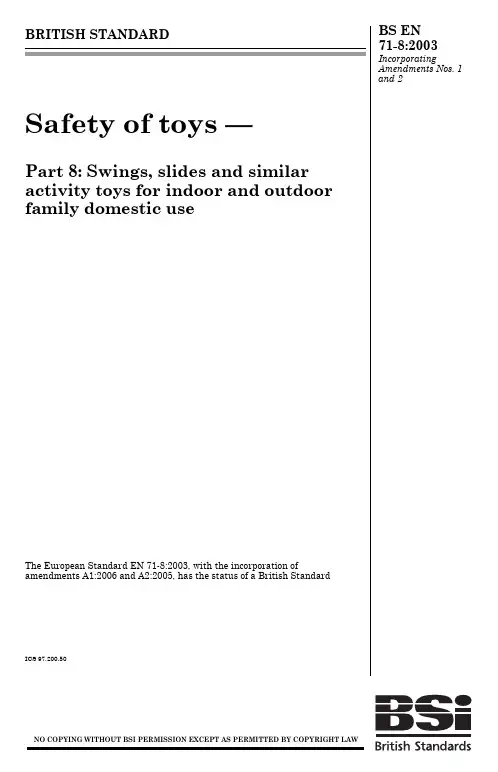
BS EN 71-8:2003IncorporatingAmendment s No s .112 &23<,1* :,7+287 %6, 3(50,66,21 (;&(37 $6 3(50,77(' %< &23<5,*+7 /$:and 2EN 71-8:2003British Standard, was hed under the authority Standards Policy and gy Committee on gust 200320060 580 42514 2National forewordThis British Standard is the official English language version of EN 71-8:2003, including amendment s A1:2006 and A2:2005.The start and finish of text introduced or altered by CEN amendment is indicated in the text by tags . Tags indicating changes to CEN text carry the number of the CEN amendment. For example, text altered by CEN amendment A1 is indicated by .The UK participation in its preparation was entrusted to Technical Committee CW/15, Safety of toys, which has the responsibility to:A list of organizations represented on this committee can be obtained on request to its secretary.Cross-referencesThe British Standards which implement international or European publications referred to in this document may be found in the BSI Catalogue under the section entitled “International Standards Correspondence Index”, or by using the “Search” facility of the BSI Electronic Catalogue or of British Standards Online.This publication does not purport to include all the necessary provisions of a contract. Users are responsible for its correct application.Compliance with a British Standard does not of itself confer immunity from legal obligations.—aid enquirers to understand the text;—present to the responsible international/European committee any enquiries on the interpretation, or proposals for change, and keepUK interests informed;—monitor related international and European developments and promulgate them in the UK.Summary of pagesThis document comprises a front cover, an inside front cover, the EN title page, pages 2 to 35 and a back cover.The BSI copyright notice displayed in this document indicates when the document was last issued.Amendments issued since publicationAmd. No. Date Comments1623928 April 2006See national foreword1629431 August 2006See national forewordEUROPEAN STANDARD NORME EUROPÉENNE EUROPÄISCHE NORM EN 71-8June2003+A2December2005ICS 97.200.50English versionSafety of toys – Part 8: Swings, slides and similar activity toys forindoor and outdoor family domestic useSécurite des jouets – Partie 8: Balançoires, toboggans et jouets d’activité similaires à usage familial en extérieur eten intérieur Sicherheit von Spielzeug – Teil 8: Schaukeln, Rutschen und ähnliches Aktivitätsspielzeug für den häuslichen Gebrauch(Innen- und Außenbereich)CEN members are bound to comply with the CEN/CENELEC Internal Regulations which stipulate the conditions for giving this European Standard the status of a national standard without any alteration. Up-to-date lists and bibliographical references concerning such national standards may be obtained on application to the Management Centre or to any CEN member.This European Standard exists in three official versions (English, French, German). A version in any other language made by translation under the responsibility of a CEN member into its own language and notified to the Management Centre has the same status as the official versions.CEN members are the national standards bodies of Austria, Belgium, Cyprus, Czech Republic, Denmark, Estonia, Finland, France, Germany, Greece, Hungary, Iceland, Ireland, Italy, Latvia, Lithuania, Luxembourg, Malta, Netherlands, Norway, Poland, Portugal, Slovakia, Slovenia, Spain, Sweden, Switzerland and United Kingdom.EUROPEAN COMMITTEE FOR STANDARDIZATIONC O M I TÉE U R O PÉE NDE N O R M A L I S A T I O NE U R O PÄI S C H E S K O M I T E E FÜR N O R M U N GManagement Centre: rue de Stassart, 36 B-1050 Brussels© 2003 CEN All rights of exploitation in any form and by any means reserved worldwide for CEN national Members. Ref. No. EN 71-8:2003 + A1:2006 + A2:2005 E+A1May2006This European Standard was approved by CEN on 5 March 2003. Amendment A1 was approved by CEN on 31 May 2006, amendment A2 was approved by CEN on 27 October 2005.N 71-8:2003 (E)ontents Pagereword (3)Scope(see A1) (5)Normative references (5)Definitions (5)Requirements (7)General(see A.2) (7)Barriers,ladders etc(see A.3) (8)Entrapment (see A.4) (9)Stability of activity toys other than slides, swings and toys with crossbeams (11)Slides (see A.5) (11)Swings (see A.6) (13)See-saws (16)Carousels and rocking activity toys (see A.7) (16)Warnings and labelling (16)Labelling (16)Assembly and installation instructions (16)Maintenance (17)Test methods (17)Stability (17)Static strength (19)Dynamic strength of barriers and handrails(see4.2.1) (21)Test for head and neck entrapment (see4.3) (23)Toggle test (see4.3.2) (28)Diameter of ropes and chains for swings (see4.6.8) (31)nex A(informative)Rationale (32)1Activity toys (32)2General requirements (see4.1) (32)3Barriers,ladders etc(see4.2) (32)4Entrapment (see4.3) (32)5Slides (see4.5) (32)6Swings (see4.6) (33)7Rocking horses and similar toys (see4.8) (33)nex B(informative)Bibliography (34)nex ZA(informative)Clauses of this European Standard addressing essential requirements or other provisions of EU Directives (35)EN 71-8:2003 (E)3ForewordThis document (EN 71-8:2003)has been prepared by Technical Committee CEN/TC 52 "Safety of Toys", the secretariat of which is held by DS.This European Standard shall be given the status of a national standard,either by publication of an identical text or by endorsement,at the latest by December 2003,and conflicting national standards shall be withdrawn at the latest by December 2003.This document has been prepared under a mandate given to CEN by the European Commission and the European Free Trade Association,and supports essential requirements of EU Directive(s).For relationship with EU Directive(s), see informative annex ZA, which is an integral part of this document.According to the CEN/CENELEC Internal Regulations, the national standards organizations of the following countries are bound to implement this European Standard:Austria,Belgium,Czech Republic,Denmark,Finland,France,Germany,Greece,Hungary,Iceland,Ireland,Italy,Luxembourg,Malta,Netherlands,Norway,Portugal,Slovakia,Spain,Sweden,Switzerland and the United Kingdom.This standard is part 8of the European Standard for Safety of toys.It should be read in conjunction with Part 1.The European Standard EN 71"Safety of toys"consists of the following parts:Part 1:Mechanical and physical properties;Part 2:Flammability;Part 3:Migration of certain elements;Part 4:Experimental sets for chemistry and related activities;Part 5:Chemical toys (sets)other than experimental sets;Part 6:Graphical symbol for age warning labelling;Part 7:Finger paints;Part 8:Swings, slides and similar activity toys for indoor and outdoor family domestic use.This part of EN 71includes clauses that have been moved from EN 71-1:1998Part 1Mechanical and physical properties .Foreword to amendment A1This document (EN 71-8:2003/A1:2006) has been prepared by Technical Committee CEN/TC 52 “Safety of toys”, the secretariat of which is held by DS.This Amendment to the European Standard EN 71-8:2003 shall be given the status of a national standard, either by publication of an identical text or by endorsement, at the latest by November 2006, and conflicting national standards shall be withdrawn at the latest by November 2006.According to the CEN/CENELEC Internal Regulations, the national standards organizations of the following countries are bound to implement this European Standard: Austria, Belgium, Cyprus, Czech Republic, Denmark, Estonia, Finland, France, Germany, Greece, Hungary, Iceland, Ireland, Italy, Latvia, Lithuania, Luxembourg, Malta, Netherlands, Norway, Poland, Portugal, Romania, Slovakia, Slovenia, Spain, Sweden, Switzerland and United Kingdom.– – – – – – – –N 71-8:2003 (E)4oreword to amendment A2his European Standard (EN 71-8:2003/A2:2005) has been prepared by Technical Committee CEN/TC 52 Safety of toys”, the secretariat of which is held by DS.his Amendment to the European Standard EN 71-8:2003 shall be given the status of a national standard, ther by publication of an identical text or by endorsement, at the latest by June 2006, and conflicting na tional andards shall be withdrawn at the latest by June 2006.his European Standard has been prepared under a mandate given to CEN by the European Commission nd the European Free Trade Association, and supports essential requirements of EU Directive(s).ccording to the CEN/CENELEC Internal Regulations, the national standards organizations o f the following ountries are bound to implement this European Standard: Austria, Belgium, Cyprus, Czech Republic, enmark, Estonia, Finland, France, Germany, Greece, Hungary, Iceland, Ireland, Italy, Latvia, Lithuania, uxembourg, Malta, Netherlands, Norway, Poland, Portugal, Slovakia, Slovenia, Spain, Sweden, Switzerland nd United Kingdom.EN 71-8:2003 (E)51Scope (see A1)This part of EN 71 specifies requirements and test methods for activity toy s for domestic family use attached to or incorporating a crossbeam ,and similar toys intended for children under 14years of age to play on or in and to bear the mass of one or more children.The scope excludes equipment intended for use in schools,kindergartens,public playgrounds,restaurants, shopping centres and similar public places dealt with in EN 1176 parts 1 to 6.2 N ormative referencesThis European Standard incorporates by dated or undated reference,provisions from other publications.These normative references are cited at the appropriate places in the text and the publications are listed hereafter.For dated references, subsequent amendments to or revisions of any of these publications apply to this European Standard only when incorporated in it by amendment or revision.For undated references the latest edition of the publication referred to applies.EN 71-1:1998Safety of toys –Mechanical and physical properties3 Definitions3.1activity toytoy intended for family domestic use,intended to bear the mass of one or more children,often attached to or incorporating a crossbeam and intended for children to play on or in.Examples of such toys are swings ,slides ,carousels and climbing frames3.2anchordevice used to fix the toy to the standing surface 3.3barrierguardrail to prevent a user passing beneath and through3.4crossbeambar or beam which forms a main load bearing part of the toy (see Figure 2)3.5entrapmenthazard presented by a situation in which a body,part of a body,or clothing is entrapped3.6forced movementmovement where the direction and the extent of the child’s movement is determined by the operation of the equipment,for example swinging, sliding, rocking and revolving3.7free height of fallthe greatest vertical distance from the clearly intended body support to the impact area belowEN 71-8:2003 (E)63.8free spacespace in,on or around the activity toy that can be occupied by a user undergoing a forced movement by the equipment (e.g., swinging, sliding, rocking, revolving).The definition of free space does not include the three-dimensional area in which a falling movement takes place3.9handrailrail intended to assist the user to balance or climb3.10platformraised level surface3.11slidestructure with inclined surface(s)on which the user slides in a defined track(see Figure1)NOTE Inclined planes,designed primarily for other purposes, such as roofs,do not constitute slides.Key:A Starting sectionB Sliding sectionC Run-out sectionD Height of slideB+C Slide lengthNOTE The dimensions A,B,and C shall be taken at the centreline of the sliding surface.Each of these sizes represents one of the zones of the sliding surface.Each zone of the sliding surface is determined by the intersection of the curve of the sliding surface(taken at the bottom of the sliding surface)and the bisecting line of the angle formed by the zones of the sliding surfaces between themselves.Figure1—Diagrammatic representation of a slide3.12suspension connectordevice which forms the direct contact between a crossbeam and the means of suspension(see Figure 2)3.13swingstructure incorporating a crossbeam, suspension connectors and a swing device with swing element and means of suspension(see Figure 2)EN 71-8:2003 (E)Key:1Swing device2Crossbeam3Suspension connector4Means of suspension5Swing element (e.g. seat, rings,bar,gondola)4RequirementsNOTE Words in italics are defined in clause 3 of this part of the standard or in EN 71-1:1998.4.1General(see A.2)4.1.1Static strengthActivity toys, when tested according to 6.2.1(strength of toys other than swings)shall not collapse such that they do not continue to comply with the relevant requirements of EN 71.NOTE Additional requirements for swings are given in4.6.2.4.1.2 Maximum heightWhen measured from the ground, there shall be no part of the activity toy where the child is able to climb, sit or stand over a height of 2500 mm.4.1.3 Corner and edges !(see A.8)"!Exposed edges shall be rounded.Corners and exposed edges on moving parts shall have a minimum radius of 3 mm. This does not apply to swing elements with a mass of 1 000 g or less, the corners and edges of which shall be rounded.(See also new A.8) "7EN 71-8:2003 (E)4.1.4Protruding partsProtruding parts such as bolt ends, threaded bolt ends and other protrusions shall be recessed or be protected in such a way that they do not constitute a hazard to users of the equipment.This requirement is applicable when protrusions are situated in places where the user is running, sliding,climbing, sitting,laying down or on accessible moving parts.Protective caps shall comply with relevant requirements in EN 71-1,clause4.9(protruding parts).Spring washers, self-locking nuts,or other locking means shall be provided for all bolts.4.1.5Climbing and swinging ropesRopes used for climbing and swinging shall have the following diameters:Ropes fixed at both ends diameter between18and45mmFree-hanging ropes fixed at upper end diameter between 25and45mm4.2 Barriers,ladders etc(see A.3)4.2.1Barriers and handrails preventing the child from falling downAny platform intended for sitting or standing1000 mm or more from the ground shall be equipped with a barrier on all sides that face outwards from the toy.Openings in the barriers to give access to slides,climbing structures and ladders are allowed.The height of the barrier shall be 600 mm minimum.For barriers with an uneven top design,a ruler of200 mm±5mm shall be used for measuring minimum height.Place the ruler horizontally on top of the barrier.Measure the vertical distance between the platform and the bottom of the ruler.The distance shall in no place be less than 600 mm.NOTE Special requirements apply for slides(see4.5.2 and4.5.3).After testing according to 6.3 (dynamic strength of barriers and handrails),no part of the barrier or handrail shall collapse, so that the toy does not comply with the relevant requirements of EN 71.4.2.2 Means of access to toysThese requirements do not apply for toys with a platform height of 600 mm or less.Ladders and similar means of access to toys shall comply with the requirements in items a)to g). Additional requirements for slides are given in4.5.4.a)Any opening shall comply with4.3.1(head and neck entrapment,probes C and D and test template D).b)The lateral width of the tread shall be 300 mm or more(see Figure 3).c)The distance between the treads shall be not more than 280 mm(see Figure 3).d)The surface of the tread shall not be slippery.This can be achieved by corrugation of the steps or by othertypes of materials.e)When ladders are provided with rungs, the diameter of the rungs shall be at least 16 mm but not morethan45mm.89f)The depth for treads on closed step ladders shall be 120 mm or more.g)The inclination for ladders that are fixed to the toy shall be between 55°and 90° to the horizontal.Dimensions inmillimetresFigure 3 —Dimensions of ladders4.3 Entrapment (see A.4)4.3.1Head and neck entrapmentActivity toys shall be constructed so that no openings create head and neck entrapment hazards either by head first or feet first passage.NOTE Hazardous situations in which this type of entrapment can be encountered include the following:completely bound openings through which a user can slide head first or feet first;partially bound or V-shaped openings; andshearing and moving openings.When choosing materials, the manufacturer shall take into account the entrapment hazards that can occur due to distortion of material during use.a)Accessible completely bound openings with a lower edge of 600 mm or more above the ground,or aboveany other surface which is of such a size that it will support a child, shall,if they allow passage of probe C (see Figure 10),also allow passage of probe D (see Figure 11)when tested in accordance with 6.5.1(head and neck entrapment in completely bound openings).b)Accessible rigid circular openings with a lower edge of 600 mm or more above the ground,or above anyother surface which is of such a size that it will support a child shall not have an internal diameter between 130 mm and 230 mm.c)Accessible completely bound openings, when tested according to 6.5.1 shall have no parts that convergein the downward direction at an angle of less than 60°if the lower edge is 600 mm or more above the ground (V-shaped opening).– – –d)Partially bound and V-shaped openings with a lower edge of 600 mm or more above the ground,or aboveany other surface which is of such a size that it will support a child, shall be constructed so that either:1) the opening is not accessible as defined in Figure13 and when tested according to 6.5.2.3 a)(headand neck entrapment in partially bound and V-shaped openings),or2)the tip of the template contacts the base of the opening when tested according to 6.5.2.3 b)(headand neck entrapment in partially bound and V-shaped openings).e)Non-rigid members (for example ropes) shall not overlap if by doing so they create openings that do notcomply with the requirements in a).f)Openings between flexible parts of suspended bridges and any rigid side members shall not be less than230 mm in diameter under the worst case condition of loading.Both loaded and unloaded situations shall be considered.4.3.2 Entrapment of clothing and haira)Slides,fireman’s poles and roofs shall be constructed so that hazardous situations in which clothing orhair can be entrapped are not created.Such situations may be created by:1)gaps or V-shaped openings in which parts of clothing can become entrapped while or immediatelybefore the user is undergoing a forced movement;2)protrusions;and3)spindles/rotating parts.When tested according to 6.6 (toggle test),entrapment of the toggle or chain shall not occur.The toggle test,as given in 6.6,is restricted to the free space,as practical experience has shown that natural material and connections between different parts can vary over time.NOTE1When using elements of circular cross section, special consideration should be given to avoid clothing and hair entanglement.This can be achieved by using spacers or similar devices.b)Slides and fireman’s poles shall be constructed so that openings located within the free space do notentrap the toggle or chain when tested in accordance with 6.6 (toggle test).c)Roofs shall be constructed so that they do not entrap the toggle or chain when tested in accordance with6.6 (toggle test).d)Spindles and rotating parts shall have means of preventing entanglement of clothing or hair.NOTE 2 This can be achieved by use of suitable covering or shields.4.3.3 Entrapment of feetSurfaces intended for standing, running or walking shall not contain any gaps likely to cause foot or leg entrapment.There shall be no gaps greater than 30 mm measured in one direction(see Figure4).1011Dimensions inmillimetresFigure 4—Measurement of surface gap on running and walking levels4.3.4Entrapment of fingersThe requirements in 4.3.4do not apply to weather induced dry cracks in solid wood.Activity toys shall be constructed so that hazardous situations in which entrapment may occur are not created.Accessible holes, slots and gaps in any rigid material,for example open ended tubes or pipes and variable gaps (excluding chains),where the body is in a forced movement and which can admit a 5mm diameter rod to a depth of 10 mm or more shall also admit a 12 mm diameter rod.4.4Stability of activity toys other than slides, swings and toys with crossbeamsNOTE Stability requirements for slides are given in 4.5.1and for swings and other activity toys with crossbeams in 4.6.1.4.4.1Stability of activity toys with a free height of fall of 600 mm or lessActivity toys with a free height of fall of 600 mm or less shall not tip over when tested according to 6.1.1(stability of activity toy s with a free height of fall of 600 mm or less).4.4.2 Stability of activity toys with a free height of fall of more than 600 mmActivity toys with a free height of fall of more than 600 mm shall not tip over when tested according to 6.1.2(stability of activity toy s with a free height of fall of more than 600 mm).4.5Slides (see A.5)4.5.1Stability of slidesSlides shall not tip over when tested according to 6.1.3 (stability of slides ).!Activity toys supplied with anchors and intended to be permanently fixed (e.g. in concrete) when in use according to the manufacturer’s instructions, shall not be subjected to stability tests.Activity toys supplied with removable ground anchors shall be tested with anchors fixed to the standing surface according to the manufacturer’s instructions.Activity toys not supplied with anchors shall be subjected to stability tests."!Slides supplied with anchors and intended to be permanently fixed (e.g. in concrete) when in use according to the manufacturer’s instructions, shall not be subjected to stability tests.Slides supplied with removable ground anchors shall be tested with anchors fixed to the standing surface according to the manufacturer’s instructions.Slides not supplied with anchors shall be subjected to stability tests. "4.5.2 Retaining sides for slidesRetaining sides for slides shall comply with the following(see Figure5):a)For slides with a height of more than1000 mm measured from the ground, the height(h)of the retainingsides shall be100 mm or more.b)For slides with a height of1000 mm or less measured from the ground, the height (h)of the retainingsides shall be50 mm or more.Retaining sides are not requiredfor the run-out section.Key:h height of the retaining sidesw width of the slideFigure5—Height of retaining sides4.5.3 Starting,sliding and run-out section on slidesNOTE For attachment slides, the platform may be used as starting section.The starting and run-out section on slides shall comply with the following(see Figure 6):a)The starting section for slides with a height of less than1000 mm measured from the ground shall have atleast the same width as the sliding section,a length of150 mm ore more and an inclination of between 0°and10° to the horizontal.The width is measured as indicated in Figure5.b)The starting section for slide s with a height of1000 mm or more measured from the ground shall have atleast the same width as the sliding section,a length of 250 mm or more and an inclination of between 0°and10° to the horizontal.The width is measured as indicated in Figure5.c)The starting section shall be provided with handrails in order to provide assistance to the child comingfrom the stair/ladder into the sitting position.For slide s with a height of less than1000 mm, the height of the handrail shall be150 mm ormore.For slide s with a height between1000 and1800 mm, the height of the handrail shall be 350 mmor more.For slide s above1800 mm, the height of the handrail shall be500 mm or more.d)The run-out section for the slide shall have a length of150 mm or more.The inclination shall be between0°and10° to the horizontal,and the height of the end of the section shall be 300 mm or less from the ground.–––1213e)The finishing end of the run-out section shall have a radius of 50 mm or more.This requirement does notapply to slide s where the run-out section ends 50 mm or less from the ground.Dimensions inmillimetresKey:A Length of starting section: 150 mm for slides with a height of less than 1000 mm (see 4.5.3 a)); 250 mm for slides with a height of 1000 mm or more (see 4.5.3 b)).BHeight of handrails (see 4.5.3 c): 150 mm for slides with a height of less than 1000 mm; 350 mm for slides with a height between1000 mm and 1800 mm; 500 mm for slides with a height above 1800 mm.Figure 6 —Requirements for slides4.5.4Means of access to slides In addition to the requirements in 4.2.2 (means of access to toys),ladders with a height of 1200 mm or more shall be provided with handrails from a height of 600 mm from the ground (see Figure 3) to the top of the slide (does not apply to ladders with rungs)(see Figure 3).4.6 Swings (see A.6)!4.6.1 Stability of swings and other activity toys with crossbeams4.6.1.1 GeneralSwings and other activity toys with crossbeams supplied with anchors and intended to be permanently fixed (e.g. in concrete) when in use according to the manufacturer’s instructions, shall not be subjected to stability tests. Swings and other activity toys with crossbeams not supplied with anchors shall be subjected to stability tests.4.6.1.2 Swings and other activity toys with crossbeams more than 1 200 mm over the groundSwings and other activity toys with crossbeams supplied with removable ground anchors shall be tested with anchors fixed to the standing surface according to the manufacturer’s instructions.When tested according to 6.1.4.1 (stability of swings and other activity toys with crossbeams more than 1 200 mm over the ground), the toy shall not tip over."4.6.2 Strength of crossbeams, swing devices and suspension connectorsWhen tested according to 6.2.2 (strength of swings), structures and/or crossbeams shall not collapse and swing devices,suspension connectors and climbing frames shall not become deformed, so that the toy does not comply with relevant requirements of EN 71.4.6.3 Swings intended for children under36 monthsSwings seats shall be provided with a back and a safety device preventing the child from falling off the seat. The following have been found appropriate:a T-bar or a protective bar with a crotch strap, the horizontal section of which shall be situatedbetween 200 mm and 300 mm above the seat;a device to fasten the child to the seat,e.g.a belt which is provided with a crotch strap.When tested according 6.2.2.2.2 (strength of swings intended for children under36 months),frames and/or crossbeams shall not collapse and swing devices,suspension connectors and climbing frames shall not become deformed, so that the toy does not comply with relevant requirements of EN 71.4.6.5Minimum clearance between swing elements,and similar equipment and adjacent structures These requirements do not apply to single swing elements in swings with a crossbeam height of1200 mm or less.The minimum clearances between adjacent swing elements shall be as given in table1:Table1—Minimum clearances between swing elementsClearances in millimetresbetween:Free swingingelementsSemi-flexibleelementsWith rigid means ofsuspensionAdjacent structureof swing deviceFree swinging elements450450450300 Semi-flexible elements450300300300 Elements with rigid meansof suspension4503003003004.6.6 Lateral stability of swing elementsThe minimum distance between the suspension points of a swing measured along the crossbeam shall be calculated as follows (see Figure 7):A= 0,04h+BText deleted!"!This requirement does not apply to swings with rigid means of suspension."!4.6.1.3 Swings and other activity toys with crossbeams 1 200 mm or less over the ground intended or children under 36 monthsWhen tested according to 6.1.4.2 (stability of swings and other activity toys with crossbeams 1 200 mm or less over the ground), the toy shall not tip over.(See also amendments to 6.1.4)"––14。
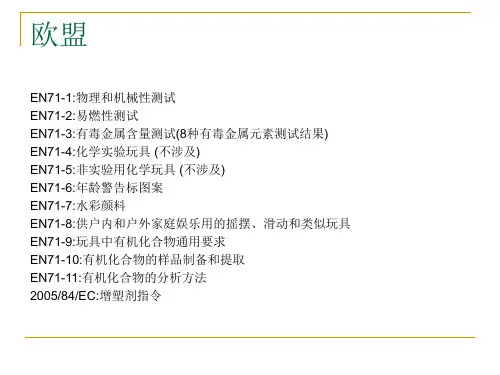
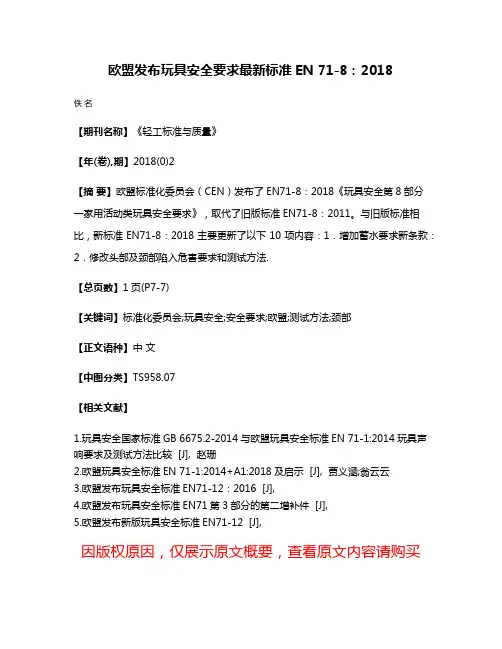
欧盟发布玩具安全要求最新标准EN 71-8:2018
佚名
【期刊名称】《轻工标准与质量》
【年(卷),期】2018(0)2
【摘要】欧盟标准化委员会(CEN)发布了EN71-8:2018《玩具安全第8部分一家用活动类玩具安全要求》,取代了旧版标准EN71-8:2011。
与旧版标准相比,新标准EN71-8:2018主要更新了以下10项内容:1.增加蓄水要求新条款:2.修改头部及颈部陷入危害要求和测试方法.
【总页数】1页(P7-7)
【关键词】标准化委员会;玩具安全;安全要求;欧盟;测试方法;颈部
【正文语种】中文
【中图分类】TS958.07
【相关文献】
1.玩具安全国家标准GB 6675.2-2014与欧盟玩具安全标准EN 71-1:2014玩具声响要求及测试方法比较 [J], 赵珊
2.欧盟玩具安全标准EN 71-1:2014+A1:2018及启示 [J], 贾义涵;翁云云
3.欧盟发布玩具安全标准EN71-12:2016 [J],
4.欧盟发布玩具安全标准EN71第3部分的第二增补件 [J],
5.欧盟发布新版玩具安全标准EN71-12 [J],
因版权原因,仅展示原文概要,查看原文内容请购买。
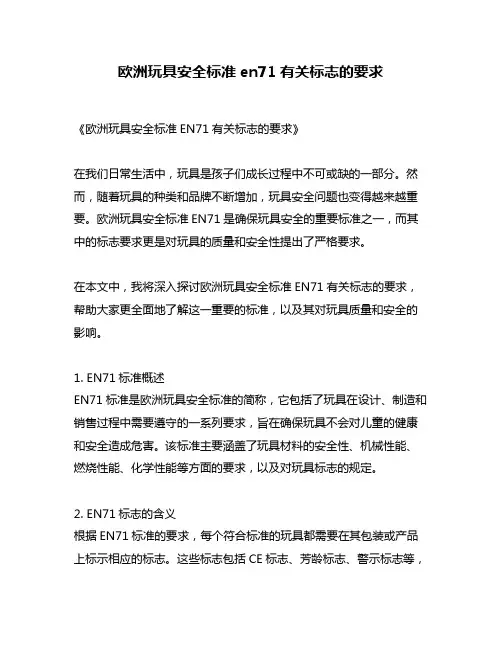
欧洲玩具安全标准en71有关标志的要求《欧洲玩具安全标准EN71有关标志的要求》在我们日常生活中,玩具是孩子们成长过程中不可或缺的一部分。
然而,随着玩具的种类和品牌不断增加,玩具安全问题也变得越来越重要。
欧洲玩具安全标准EN71是确保玩具安全的重要标准之一,而其中的标志要求更是对玩具的质量和安全性提出了严格要求。
在本文中,我将深入探讨欧洲玩具安全标准EN71有关标志的要求,帮助大家更全面地了解这一重要的标准,以及其对玩具质量和安全的影响。
1. EN71标准概述EN71标准是欧洲玩具安全标准的简称,它包括了玩具在设计、制造和销售过程中需要遵守的一系列要求,旨在确保玩具不会对儿童的健康和安全造成危害。
该标准主要涵盖了玩具材料的安全性、机械性能、燃烧性能、化学性能等方面的要求,以及对玩具标志的规定。
2. EN71标志的含义根据EN71标准的要求,每个符合标准的玩具都需要在其包装或产品上标示相应的标志。
这些标志包括CE标志、芳龄标志、警示标志等,它们都是玩具符合EN71标准的重要证明。
3. CE标志CE标志是欧洲共同市场的产品安全认证标志,也是符合EN71标准的玩具必须标注的标志之一。
该标志表明玩具符合欧洲经济区的相关法律要求,可以在这一范围内自由流通和销售。
对于父母来说,在购买玩具时要注意查看玩具上是否有CE标志,以确保其安全性和质量。
4. 芳龄标志根据EN71标准的要求,玩具的包装或产品上必须标注适合的芳龄范围,以便消费者选择适合孩子的玩具。
芳龄标志的设置不仅考虑了不同芳龄段儿童的生理和认知发展特点,还考虑了玩具本身的设计和材质特性,以防止儿童因使用不当而造成意外伤害。
5. 警示标志在EN71标准中,还规定了一些特定的警示标志,用于提醒消费者玩具可能存在的风险或需要特别注意的地方。
小零件警示标志、窒息危险标志等,这些警示标志的设置有助于引起消费者的注意,避免因不当使用而导致意外伤害。
总结通过本文的介绍,我们了解了欧洲玩具安全标准EN71有关标志的要求,包括CE标志、芳龄标志、警示标志等。
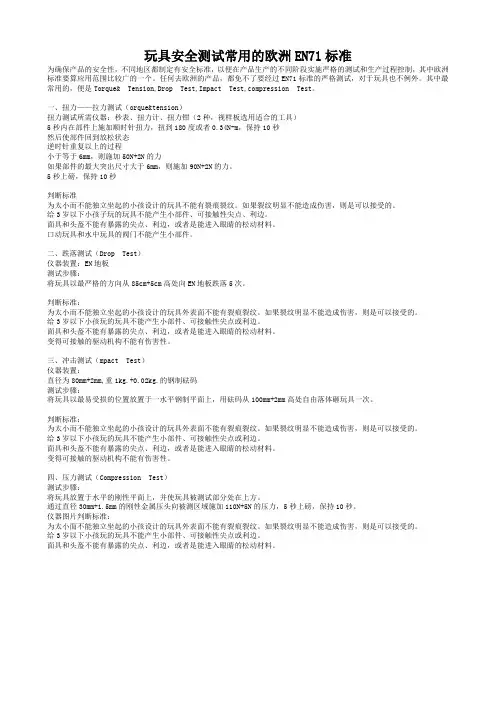
玩具安全测试常用的欧洲EN71标准为确保产品的安全性,不同地区都制定有安全标准,以便在产品生产的不同阶段实施严格的测试和生产过程控制,其中欧洲标准要算应用范围比较广的一个。
任何去欧洲的产品,都免不了要经过EN71标准的严格测试,对于玩具也不例外。
其中最常用的,便是Torque& Tension,Drop Test,Impact Test,compression Test。
一、扭力——拉力测试(orque&tension)扭力测试所需仪器:秒表、扭力计、扭力钳(2种,视样板选用适合的工具)5秒内在部件上施加顺时针扭力,扭到180度或者0.34N-m,保持10秒然后使部件回到放松状态逆时针重复以上的过程小于等于6mm,则施加50N+2N的力如果部件的最大突出尺寸大于6mm,则施加90N+2N的力。
5秒上磅,保持10秒判断标准为太小而不能独立坐起的小孩设计的玩具不能有裂痕裂纹。
如果裂纹明显不能造成伤害,则是可以接受的。
给3岁以下小孩子玩的玩具不能产生小部件、可接触性尖点、利边。
面具和头盔不能有暴露的尖点、利边,或者是能进入眼睛的松动材料。
口动玩具和水中玩具的阀门不能产生小部件。
二、跌落测试(Drop Test)仪器装置:EN地板测试步骤:将玩具以最严格的方向从85cm+5cm高处向EN地板跌落5次。
判断标准:为太小而不能独立坐起的小孩设计的玩具外表面不能有裂痕裂纹。
如果裂纹明显不能造成伤害,则是可以接受的。
给3岁以下小孩玩的玩具不能产生小部件、可接触性尖点或利边。
面具和头盔不能有暴露的尖点、利边,或者是能进入眼睛的松动材料。
变得可接触的驱动机构不能有伤害性。
三、冲击测试(mpact Test)仪器装置:直径为80mm+2mm,重1kg.+0.02kg.的钢制砝码测试步骤:将玩具以最易受损的位置放置于一水平钢制平面上,用砝码从100mm+2mm高处自由落体砸玩具一次。
判断标准:为太小而不能独立坐起的小孩设计的玩具外表面不能有裂痕裂纹。
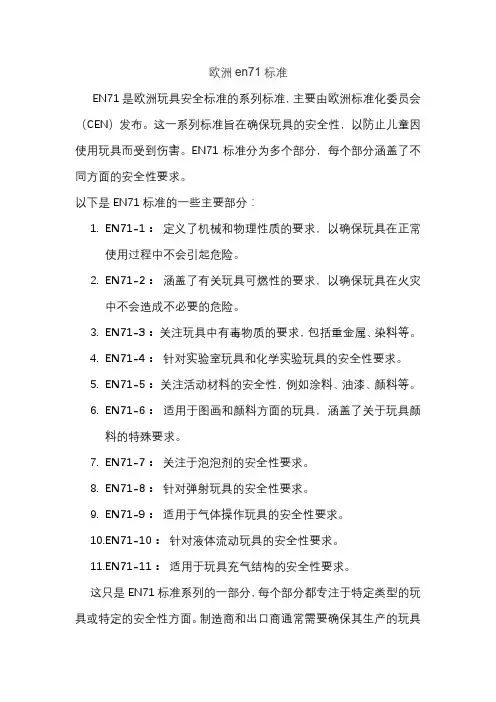
欧洲en71标准
EN71是欧洲玩具安全标准的系列标准,主要由欧洲标准化委员会(CEN)发布。
这一系列标准旨在确保玩具的安全性,以防止儿童因使用玩具而受到伤害。
EN71标准分为多个部分,每个部分涵盖了不同方面的安全性要求。
以下是EN71标准的一些主要部分:
1.EN71-1:定义了机械和物理性质的要求,以确保玩具在正常
使用过程中不会引起危险。
2.EN71-2:涵盖了有关玩具可燃性的要求,以确保玩具在火灾
中不会造成不必要的危险。
3.EN71-3:关注玩具中有毒物质的要求,包括重金属、染料等。
4.EN71-4:针对实验室玩具和化学实验玩具的安全性要求。
5.EN71-5:关注活动材料的安全性,例如涂料、油漆、颜料等。
6.EN71-6:适用于图画和颜料方面的玩具,涵盖了关于玩具颜
料的特殊要求。
7.EN71-7:关注于泡泡剂的安全性要求。
8.EN71-8:针对弹射玩具的安全性要求。
9.EN71-9:适用于气体操作玩具的安全性要求。
10.E N71-10:针对液体流动玩具的安全性要求。
11.E N71-11:适用于玩具充气结构的安全性要求。
这只是EN71标准系列的一部分,每个部分都专注于特定类型的玩具或特定的安全性方面。
制造商和出口商通常需要确保其生产的玩具
符合EN71标准的适用部分,并通过相关的测试和认证程序,以确保玩具的安全性和合规性。
EN71-欧洲玩具安全标准-中文EN71-欧洲玩具安全标准是针对儿童玩具在欧洲市场上的安全性要求所制定的一套标准。
该标准的目的是保证儿童玩具在使用过程中不会对儿童的生命和健康造成伤害。
根据EN71标准的要求,玩具的生产和销售应符合以下几个方面的安全标准:1. 物理性能:玩具的结构设计应保证其在正常使用中不易损坏或变形,避免潜在的尖锐边缘、松动零部件和吞食风险。
此外,玩具的表面和材料应具备足够的耐磨和耐撕裂能力,以减少儿童的误用可能造成的危险。
2. 化学性能:EN71标准明确规定了可以使用的化学物质和材料的限制。
玩具不得含有对健康有害的重金属、有毒有害的染料和颜料,以及致敏物质等。
此外,标准还对可溶性物质的含量、有机挥发物的迁移限制等进行了规定,以确保玩具在正常使用中不会对儿童造成化学中毒风险。
3. 点燃性能:EN71标准对于可燃材料的使用和易燃性进行了限制。
这尤其重要,因为玩具可能会接触到明火或高温物体,如蜡烛、打火机等。
因此,玩具材料不得易燃,且不能产生大量有毒烟雾。
4. 声学性能:该标准还要求玩具在使用中产生的声音不能超过规定的安全限值。
这是为了避免过大的噪音刺激对儿童的听觉健康产生不良影响。
5. 标签和警示:EN71标准要求玩具上应贴有相关的标志或警示。
这些标志可以包括年龄适用范围、警示语、注意事项等,帮助消费者正确选择和使用玩具。
欧洲玩具市场十分重视儿童玩具的安全性,因此EN71标准得到了广泛的应用和遵守。
符合EN71标准的玩具可以获得CE认证,这是销售欧洲市场的必要条件。
对于消费者来说,购买符合EN71标准的玩具可以更好地保护儿童的安全和健康。
在EN71标准的指导下,欧洲的玩具制造商必须确保其产品在设计、制造和质量控制方面符合标准的要求。
首先,他们需要确保玩具的物理性能符合标准,以降低意外伤害的风险。
这包括确保玩具没有尖锐的边缘或角,没有松动或易脱落的部件,以及能承受儿童正常的使用压力和拉扯。
EN71欧洲玩具安全标准1、机械和物理特性2、易燃性3、某些成分的转移第一部分:机械和物理特性1)欧洲标准规定了要求并说明了玩具制造过程中的检测方法。
目的是尽可能减少使用者不易发现的危险。
但不包括对儿童和照看儿童的人明显的内在危险。
2)带背衬面积不大于100X100毫米的柔韧塑料薄膜的平均厚度不小于0.38MM。
平均厚度是在一块薄膜的对角线上取10点进行测量后确定。
这一厚度规格不适用于那些小孩并能通过薄膜呼吸的柔韧塑料材料。
该厚度的薄膜不能形成真空和贴到小孩的脸上。
为达到这一要求。
在任一30X30MM的面积上。
孔的面积最少为1%,3)玻璃:除用来做拔浪鼓和玻璃眼睛的玻璃球以外,36个月以下幼儿的玩具不许用玻璃制造。
36个月以上的儿童使用的玩具在制造时必须要用玻璃时,仅用在玩具功能必需的地方(如光学玩具),用增强纺织玻璃纤维及其硬玻璃球。
使用玻璃制造的东西,其边缘应磨圆,必要时采取保护措施。
4)填充材料:软填充材料内不应有硬物和尖刺。
如:金属碎片、钉、针、以及木屑和塑料屑等,颗粒填充材料,其最大尺寸在3MM及3MM以下的应装在内包装内,所说的内包装不应是玩具的表面,由软材料制做的玩具,其内装的填充材料颗粒尺寸为3MM或3MM以下的。
内包装的缝及任何地方至少都能承受任意方面的70牛顿的力。
5)边缘:金属边缘的厚度小于0.5MM应做如下处理.A、不应是锋利边缘。
B、做成弯边、卷边或螺旋边。
C、加塑料保护涂层。
做切削的刀锋玩具仅供36个月以上的儿童使用,并提醒使用者注意刀锋危险。
膨胀材料:根据第4.16条,不应使用其体积可比原来增大百分之五的种子及其他可膨胀材料弯边角度小于270度,L=0.7MM(最大);卷边角度在270-360度之间L=1.5MM(最大);螺旋边角度大于360度L不限6)搭接:金属片与其底层结构之间的间隙大于0.7MM时金属片的边缘按第3.2.1.1条的标准要求来处理.7)加固件:生产玩具所用的螺钉、钉等类似的加固的连接端不应被触摸到,可触摸到的紧固件应无毛刺。
欧盟玩具产品EN71认证要求欧盟玩具CE认证检测主要考虑三个标准:EN71为欧盟的玩具CE认证检测标准,目前来讲主要是检测EN71-1,EN71-2,EN71-3。
三个测试标准,-1和-2是固定的价格,-3是根据产品使用的材料,颜色来算的。
欧盟玩具CE认证EN71测试项目:1.欧盟玩具CE认证EN71-1指令要求:玩具安全-第1部分:物理和机械性能。
该部分主要包括跌落测试、小零件测试、锐利边缘测试、拉力测试、压力测试、线缝测试、耳鼻眼拉力、扭力测试等2.欧盟玩具CE认证EN71-2指令要求:玩具安全-第2部分:阻燃性能。
该部分规定了所有玩具禁止使用的易燃材料种类及对某些小型火源的玩具的燃烧性能要求。
要求被测试材料的燃烧速度不得超过标准规定的限值。
涉及到戴在头上的玩具、玩具化装服饰和供儿童在玩耍中穿戴的玩具、供儿童进入的玩具、含毛绒或纺织面料的软填充玩具。
?3.欧盟玩具CE认证EN71-3指令要求:玩具安全-第3部分:某些元素的转移。
该部分规定了玩具的可触及部件或材料中可迁移元素(锑、砷、钡、镉、铬、铅、汞、锡)的最大限值。
其测试原理是:可溶性元素是模拟材料在吞咽后与胃酸持续接触一段时间的条件下,从玩具材料中提取出的溶出物。
采用检出限适当的方法定量测定可溶性元素的含量。
4,欧盟玩具CE认证EN71-4指令要求:玩具安全-第4部分:化学和有关活动用的试验装置。
EN71-4规定了在化学试验装置及相关活动设备中使用的化学物质的限值。
也包括化学、生物学、物理学、微生物和环境科学等领域中的试验玩具,同时也规定了标签、化学物质使用清单及使用说明书的相关要求。
5.欧盟玩具CE认证EN71-5指令要求:玩具安全-第5部分:化学玩具(试验装置除外)。
EN71-5规定了化学玩具中有害物质使用的限制及要求主要应用于模制和浇铸装置中的石膏、灰泥。
微型台装置中的陶瓷和玻璃制品上色材料;造型粘土装置中的烤箱可塑PVC料;塑胶浇铸装置;嵌入装置;照相洗印装置;模具中使用的粘合剂、油漆、清漆、稀释剂和清洁剂。
en71欧盟儿童玩具安全标准EN71欧盟儿童玩具安全标准是指欧洲儿童玩具的安全要求和测试方法,以保护儿童免受玩具产品带来的潜在危险。
它由欧盟委员会颁布,是欧洲内部市场的强制性法规。
EN71标准共分为十部分,覆盖了儿童玩具的各个方面,包括玩具的物理和机械性质、燃烧性、化学性质、电气性质、纺织品和填充物的材质等。
下面将对EN71标准的主要内容进行介绍。
首先,EN71-1标准规定了玩具的物理和机械性质的要求。
这包括了对玩具的尺寸、形状、边缘、表面光滑度、机械功能等方面的要求。
玩具应具备足够的强度和耐久性,以确保在正常使用条件下不会对儿童造成伤害。
其次,EN71-2标准规定了玩具的燃烧性要求。
根据标准,玩具应具备一定的抗燃性能,以防止火灾和火灾后的烟雾产生。
玩具的材质和构造应能耐受一定程度的火焰和热源。
EN71-3标准规定了玩具的化学性质要求。
玩具的材料不得含有有害物质,如铅、铬、汞、镉等。
此外,还规定了对某些有害物质的特定限制,如对印染剂和颜料中某些有毒物质含量的限制。
EN71-4标准规定了玩具的电气性质要求。
玩具中使用电池或电源的部分应具备足够的安全保护措施,以防止电流过大、电源过热等问题。
标准还规定了玩具应符合欧洲低压指令的要求。
EN71-5标准规定了玩具中使用的化学材料的要求,包括颜料、印染剂、涂料等。
这些材料应符合欧洲化学品法规REACH的要求,不得含有有害物质。
EN71-6标准规定了玩具中使用的纺织品和填充物的材质要求。
这些材料应具备足够的抗菌性、有害物质含量限制等要求,以确保儿童使用时的安全和卫生。
除以上几个主要标准外,EN71标准还包括了玩具标志、使用说明书、包装材料、儿童吸入和咽喉阻塞的要求,以及对不同年龄段儿童玩具的特殊要求等。
总之,EN71欧盟儿童玩具安全标准为欧洲的儿童玩具提供了一系列严格的安全要求和测试方法。
通过遵守这一标准,生产商可以确保其产品符合欧洲市场的安全要求,从而保护儿童的生命和健康。
EN71玩具安全标准1. 简介EN71是指玩具安全的欧洲标准,即欧洲玩具安全标准EN71。
它规定了对于欧洲市场销售的儿童玩具的设计和制造的安全要求。
EN71标准是欧洲玩具安全指令的基础,它旨在保护儿童免受玩具使用时可能导致的伤害。
2. 标准主要内容EN71标准包含了许多不同方面的要求,以确保玩具的安全性、可靠性和质量。
以下是EN71标准的主要内容:2.1. 物理和机械性能要求EN71标准规定了玩具的物理和机械性能要求,以确保玩具在正常使用过程中不会导致儿童受伤。
这些要求包括对玩具的耐磨性、抗冲击性、抗拉力、抗压缩等方面的测试。
2.2. 化学性能要求EN71标准对玩具中使用的材料进行了严格的化学性能要求,以确保不会存在对儿童健康有害的物质。
这些要求包括对玩具材料的禁用物质列表以及对玩具材料中有害物质含量的限制。
2.3. 燃烧性能要求EN71标准规定了玩具的燃烧性能要求,以确保玩具在受到明火照射时不会过于燃烧或产生有害的烟雾。
这些要求包括对玩具的燃烧点、燃烧速率和烟雾密度等方面的测试。
2.4. 标签要求EN71标准规定了关于玩具标签的要求,包括标识必要的警告信息、年龄限制、生产商信息等。
这些标签可以提供给用户有关玩具使用和安全的重要信息。
3. 标准适用范围EN71标准适用于销售给欧洲市场的儿童玩具。
在进入欧洲市场之前,所有生产和销售的儿童玩具都必须符合EN71标准的要求。
4. 相关测试方法为了评估玩具是否符合EN71标准的要求,需要进行一系列的测试。
以下是一些常用的测试方法:•物理和机械性能测试:例如耐磨测试、抗冲击测试、抗拉力测试等。
•化学性能测试:例如重金属含量测试、禁用物质测试等。
•燃烧性能测试:例如燃烧点测试、烟雾密度测试等。
5. 有效性和合规性EN71标准是欧洲市场上对玩具安全性的主要参考标准之一。
符合EN71标准的玩具可以证明其符合欧洲安全要求,提高了消费者对玩具的信任度。
为了确保玩具的合规性,生产商和供应商应该对其产品进行测试,并获得相应的证书。